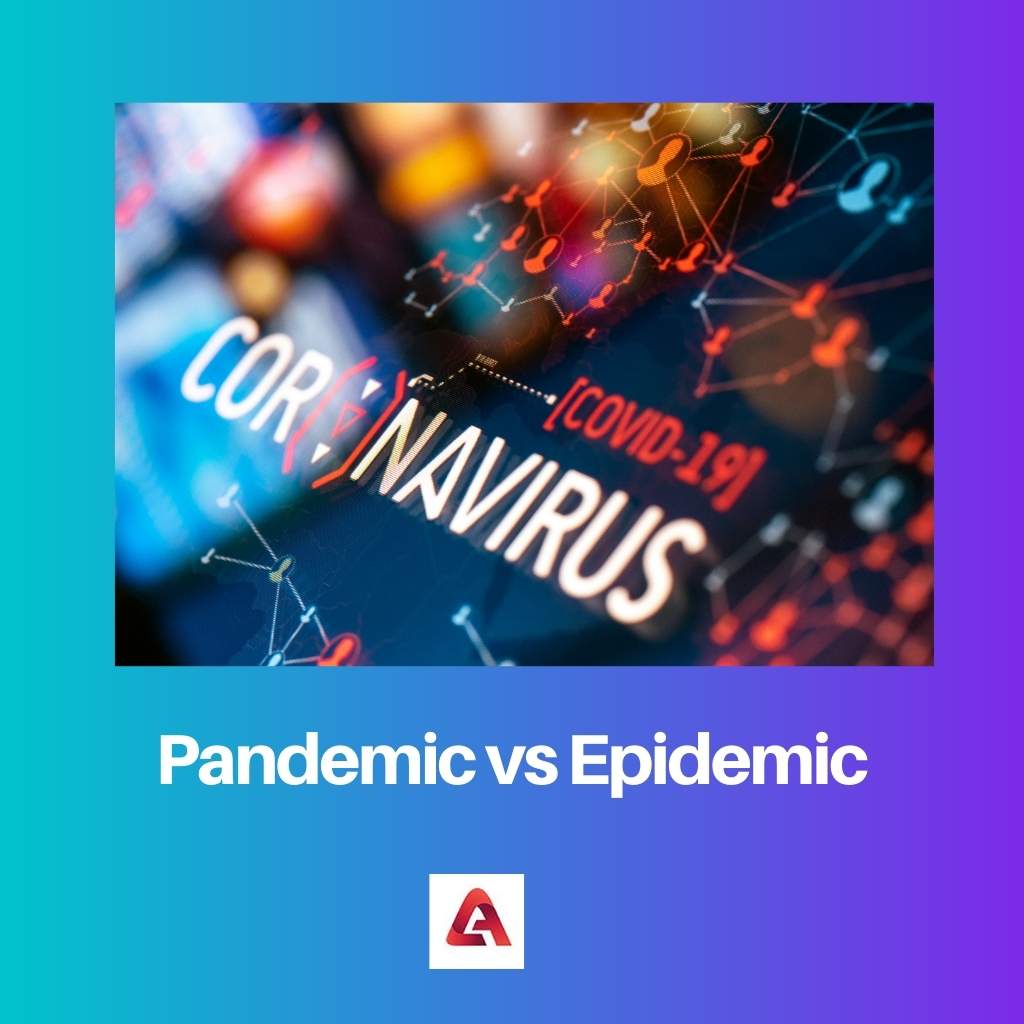The earth, as a planet, bores several living organisms as well as several non-living organisms. It is home to several abiotic and biotic factors that have existed for many years.
The existence of these living and non-living organisms lead to certain consequences, and these consequences appear as a result of the activities that are carried out by the same living and non-living organisms.
These consequences include various changes in the surroundings. The normal routine and the respective harmony are disrupted. These consequences include global warming, imbalance in nature leading to natural calamities, outbreaks of various diseases, manmade mishaps etc.
However, the outbreaks of diseases lead to either a pandemic or an epidemic.
Key Takeaways
- Pandemics affect a larger geographic area, crossing international borders and impacting a significant portion of the global population.
- Epidemics remain confined to a specific region, causing a sudden increase in the number of cases of a disease.
- Both require public health measures and interventions to control and mitigate their impact.
Pandemic vs Epidemic
A pandemic is an outbreak of an infectious disease that spreads globally and affects a large number of people. A pandemic can occur when a new virus or bacteria emerges that can easily spread between humans. An epidemic is the rapid spread of an infectious disease within a specific population or geographic area. Epidemics can occur when a pathogen is introduced into a population where there is little or no immunity.

The sudden outbreak of a disease or a virus that takes place globally is known as a pandemic. In the history of the world, there have been several pandemics of several diseases. The effect of these pandemics varies depending on their severity.
These pandemics are a result of the several human activities that take place all around the world, and they eventually disrupt human lives. A sudden outbreak of a disease or virus that takes place in a specific area at a specific time is known as an epidemic.
There are several reasons and changes that are responsible for the triggering of an epidemic. There are also different types of these epidemics. Whichever the type is, human lives are disrupted no matter what. In the history of the world, several epidemics have taken place.
Comparison Table
| Parameters of Comparison | Pandemic | Epidemic |
|---|---|---|
| Meaning/ Definition | The sudden outbreak of a disease or a virus that takes place globally is known as a pandemic. | A sudden outbreak of a disease or virus that takes place in a specific area at a specific time is known as an epidemic. |
| Spread | Unlimited spread. A certain country or even the entire world can be affected. | Limited spread. A certain area or a certain part of the world is affected. |
| Death Rate | More | Less |
| Geographical Spread | Continents, countries or even the entire world. | Community, population or a region |
| Examples | Malaria, Polio, Smallpox, Yellow Fever, Measles, Chickenpox etc. | Malaria, Polio, Smallpox, Yellow Fever, Measles, Chickenpox etc. |
What is Pandemic?
The sudden outbreak of a disease or a virus that takes place globally is known as a pandemic. Over the years, many pandemics have taken place. However, the most lethal pandemic that took place in the history of the world is the Black Death or the Plague pandemic.
There are other pandemics that have taken place in the history of the world as well. In the history of the world, there have been several pandemics of several diseases.
The effect of these pandemics varies depending on their severity. These pandemics are a result of the several human activities that take place all around the world, and they eventually disrupt human lives. The management and prevention of the pandemic is an extremely crucial and difficult part.
However, the management of the pandemic includes containment and alleviation as two of their important strategies. The containment strategy includes the announcement of lockdowns and other steps. The alleviation strategy includes vaccination and other aids.
People that get affected during a certain pandemic face some serious repercussions and losses. It is important for us to follow the protocols and guidelines to keep ourselves and the people around us safe and sound. We need to maintain the code of conduct by following the guidelines and doing our bit to end the pandemic.

What is Epidemic?
A sudden outbreak of a disease or virus that takes place in a specific area at a specific time is known as an epidemic. The word “epidemic” is derived from the Greek words “epi” and “demos”, which means “above” and “people”.
The death rate is comparatively less in an epidemic as it affects a comparatively less population. There are several reasons and changes that are responsible for the triggering of an epidemic.
There are also different types of these epidemics. Whichever the type is, human lives are disrupted no matter what. In the history of the world, several epidemics have taken place. The epidemics have a lesser spread and can be controlled if proper precautions and management are done.
Generally, an epidemic is restricted to a certain location and a certain amount of population, but if the reach expands and the amount of population that is affected increases, then it may lead to a pandemic.
It does not necessarily lead to a pandemic if the management of the epidemic at its early stages is done appropriately. People suffer financial, emotional, and physical losses, and thus the nation suffers from a number of losses as well.
Human activities lead to these epidemics, and these epidemics thereby affect the lives of several humans. People lose their lives or their loved ones and suffer a lot. That is why one must always follow the guidelines and protocols laid by the authorities in order to end a certain epidemic.

Main Differences Between Pandemic and Epidemic
- The sudden outbreak of a disease or a virus that takes place globally is known as a pandemic. On the other hand, A sudden outbreak of a disease or virus that takes place in a specific area at a specific time is known as an epidemic.
- The death rate is higher in pandemics as compared to the death rate in epidemics.
- The pandemic affects continents, countries or even the entire world. On the other hand, the epidemic affects a certain amount of the population and a specific location.
- The pandemic requires more management and strategies. On the other hand, the epidemic requires comparatively less management and implementation of strategies.
- Examples of pandemics include the coronavirus pandemic, HIV/AIDS pandemic etc., on the other hand, the examples of epidemics include malaria, polio, yellow fever etc.

- https://academic.oup.com/jid/article-abstract/200/7/1018/903237
- https://journals.aps.org/rmp/abstract/10.1103/RevModPhys.87.925

Emphasizing the importance of adherence to public health guidelines and protocols is crucial in mitigating the impact of pandemics and safeguarding individuals’ health and well-being.
Compliance with preventive measures is indispensable to curb the transmission of infectious diseases and prevent their escalation into pandemics.
Public awareness campaigns and community engagement are pivotal in promoting adherence to public health guidelines and fostering a collective response to mitigate the impact of pandemics and epidemics.
Educating the public about preventive measures and disease transmission is essential in empowering individuals to contribute to infection control efforts during outbreaks.
Vaccination and other forms of medical intervention play a pivotal role in mitigating the impact of pandemics by bolstering immunity and reducing disease transmission.
The development and distribution of vaccines are critical components of pandemic management, contributing to population immunity and disease control.
Epidemics, on the other hand, are localized outbreaks that can still have devastating effects in a specific region. It is crucial to monitor and address epidemics with urgency.
Effective surveillance and rapid intervention are vital to prevent an epidemic from escalating into a pandemic.
The management and prevention of pandemics require comprehensive strategies that address containment, treatment, and vaccine development. This necessitates a concerted global effort.
Understanding the key differences between pandemics and epidemics is essential for public health authorities to develop appropriate response measures tailored to each situation.
Absolutely, targeted interventions are critical in managing the spread of infectious diseases during both pandemics and epidemics.
The historical context of pandemics, such as the Black Death, highlights the catastrophic impact of these global outbreaks. It underscores the need for preparedness and robust response mechanisms.
Agreed, proactive measures and international collaboration are essential for mitigating the consequences of pandemics and safeguarding public health.
The severity of pandemics necessitates a multifaceted approach, encompassing rapid response, resource mobilization, and community engagement to limit their adverse effects.
The comparison table effectively summarizes the disparities between pandemics and epidemics, providing a clear distinction between the two public health phenomena.
The systematic evaluation of these differences is indispensable for health professionals and policymakers in formulating appropriate strategies.
Targeted public health measures and heightened surveillance are essential in containing epidemics, preventing further spread, and protecting vulnerable populations.
Rapid identification of cases, contact tracing, and isolation are pivotal strategies in curtailing the transmission of infectious diseases during epidemics.
It is important to note that pandemics have a wider scope than epidemics, affecting a larger population. Containment of pandemics is a challenging task that requires prompt action and collaboration between countries.
Indeed, pandemics require international cooperation and coordination to mitigate their impact.
Pandemics pose a significant threat to global public health and necessitate immediate and comprehensive responses.